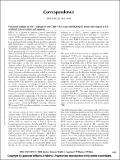| dc.description.abstract | HIV-1 Tat is known to influence several intracellular
functions including its ability to activate long terminal
repeat (LTR) promoter-mediated transactivation and
cause apoptosis [1–3]. Although a number of studies have
been performed with subtype B gene products, relatively
little information is available for subtype C, which is
responsible for causing more than 50% infections
worldwide, including India where it is the major subtype.
In the present study, we constructed several recombinant
clones of Tat-B (derived from pNL4-3) [4] and Tat-C
(derived from an Indian isolate which is 95% similar to
the consensus subtype C based on its amino acid sequence
[5] (clone 93IN905, GenBank Accession no. AF067158)
[6] with respect to the two exons for fine functional
domain analysis. It is worth noting that most subtype C
isolates possess QGD compared with RGD in the second
exon of Tat gene in the same position (78–80 amino
acids) (a known cell adhesion motif), which is associated
with integrin-mediated signaling and cell adhesion, etc.,
besides other changes throughout the gene. We reasoned
that these changes might modulate its ability to
transactivate LTR promoters and apoptosis. Therefore,
we made constructs of subtypes B and C Tat that
consisted of either the RGD or QGD motif and also
swapped the first and second exons of the Tat gene.
Precise gene fusion technologywas used to generate such
chimeric constructs as described by one of us earlier [7]
and confirmed by sequencing. The various constructs
made are indicated at the bottom of Fig. 1a with Tat-B
and Tat-C with RGD/QGD domains. An internal
reporter gene control (pSV-b-gal; Promega, Madison,
Wisconsin, USA) was always included to ensure uniform
transfection efficiency. | en_US |

